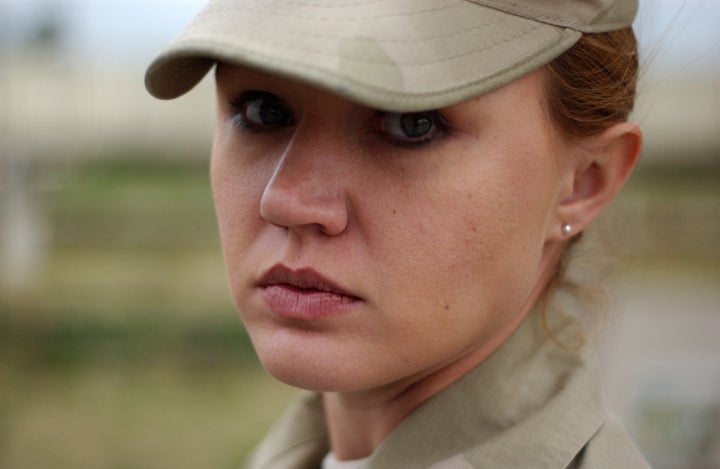
After a rocket-propelled grenade sent the Black Hawk helicopter tumbling out of the sky over Iraq, the medics got to work fast on the co-pilot, Capt. Duckworth. Standard operating procedure: cut away the desert-camo uniform before burnt fabric melds with burnt flesh. Get at the wounds. Stop the bleeding. Save what's left.
When you show up at Walter Reed Medical Center in that kind of condition, you show up naked, with nothing except the hospital gown. So you're given a "comfort kit," a little backpack containing some toiletries and clothes. Duckworth awoke there around Thanksgiving 2004, a few weeks after the shootdown, to find a comfort kit waiting with slippers, a shaving kit and men's jockey shorts.
She had to laugh.
"It was great. I don't have feet, so I can't wear the slippers, and you know, I just had my legs blown off, it's not like I'm gonna shave my legs any time soon," she chuckles. "I don't have jockey, I'm not gonna wear men's jockey shorts."
Tammy Duckworth had just become the first female double amputee from Iraq, losing one leg above the knee and one below, but she had been a woman for a while already.
"They just had kits for men," Duckworth says. "It never occurred to them to make kits for women."
Duckworth is one of more than 282,000 American women who have deployed to Iraq and Afghanistan during a decade of war, according to Pentagon figures. That's more than six times the number of women deployed in the first Gulf War and more than 35 times the number sent to Vietnam.
(An interactive timeline of U.S. women at war can be found here.)
The 207,308 women currently serving on active duty comprise some 14.5 percent of the U.S. armed forces, according to the military. While more than 2 million women have served since the Revolutionary War, some 1.9 million of them are currently living -- an unprecedented generation of women at war. The number of female veterans has doubled since 1990 and is expected to skyrocket given further drawdowns in the Middle East.
They are helicopter pilots, linguists and flight nurses, mechanics, mental health administrators and homeland security-force directors, intelligence officers and combat correspondents, Ph.D.s and amputees, Purple Heart recipients and prisoners of war. Over seventy have become generals. Two, one in the Army and another in the Air Force, have four stars.

Yet while women are undeniably at war, the full extent of their roles and capabilities still isn't formally recognized by the military brass. Today's servicewomen perform many of the roles that official policy says they cannot. Often, their service and suffering remain ignored by or invisible to the Pentagon and the public.
"First thing we can do for women veterans is to raise the awareness that women are veterans," says Maj. Gen. Irene Trowell-Harris, director of the Center for Women Veterans at the Department of Veterans Affairs and the first African American woman to reach the rank of general in the National Guard.
Of the 1.2 million positions available throughout the military, 252,179, roughly 21 percent, are closed to women, according to a Department of Defense report to Congress ordered under the defense budget bill for fiscal year 2011. At the report's release in February, the DOD announced plans to open 14,325 more jobs -- an additional 1.2 percent of that total -- slated for implementation on Monday.
 All graphics by Chris Spurlock. A detailed table can be found here.
All graphics by Chris Spurlock. A detailed table can be found here.
"The Department of Defense is committed to removing all barriers that would prevent Service members from rising to the highest level of responsibility that their talents and capabilities warrant," the report says. But it continues, voicing the concern of those who oppose women in combat: "There are serious practical barriers, which if not approached in a deliberate manner, could adversely impact the health of our Service members and degrade mission accomplishment. Change of this magnitude requires sufficient time and resources."
Incremental reforms, however, don't address the fundamental problem: a segregated system that denies women the chance to compete for the most elite positions in the military -- typically the fast track to advancement through the ranks -- as well as the respect that their service and sacrifice has earned.
That hasn't stopped Duckworth, named President Barack Obama's assistant secretary of Veterans Affairs in 2009 and now a Democratic candidate for Congress in Illinois. Yet for every Duckworth, thousands of military women remain trapped between the Pentagon's policy and practice, between rhetoric and reality.
'LET'S NOT TELL HIM UNTIL THE WAR'S OVER'
American women have served in the military since there has been an America to serve. During the Civil War, women on both sides disguised themselves as men to enlist. More than 400,000 women served during the World Wars, but as the United States demobilized, the military pushed women back to the homefront.

During Vietnam, Congress began to recognize that more women were needed for the U.S. military machine, repealing legal provisions that had prevented them from comprising more than 2 percent of the nation's troops. With the end of the draft in 1973, the military turned greater attention toward recruiting women, but struggled to treat them as equals -- the Pentagon's 1988 "Risk Rule" officially excluded women even from support missions if they were deemed as likely as combat troops to take a bullet.
The first Gulf War soon proved this doctrine untenable, however, as a clear gap emerged between the risk rule and the facts on the ground.
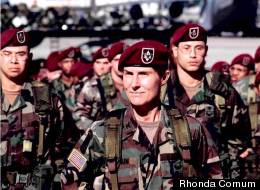
You know, women aren't supposed to be in combat, Cornum recalls a colleague telling her at their staging grounds in Saudi Arabia just before the U.S. air assault on Iraq.
"Right, I know that," was her answer.
Do you think the colonel knows you're a girl? he asked.
"I said, 'Well, I've been living in the parking space next to him in the Dhahran Airport parking lot for the last four months,'" she says. "'If he doesn't know by now, let's not tell him until the war's over.'"
This kind of doublethink was a standard part of Cornum's experience in the Gulf. "So when people would come around or dignitaries would come," she says, "they'd send me off to the motor pools."
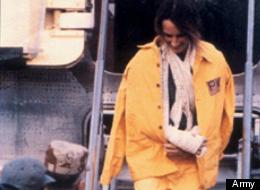
On the last day of the war in 1991, Cornum's Black Hawk was downed by Iraqi forces during a rescue mission. She broke both her arms and a finger, tore knee ligaments and, yes, took a bullet, but nonetheless managed to crawl out of the wrecked bird. She and the two other survivors of her eight-person crew spent a week as Iraqi prisoners of war before being released.
"Nobody made any comments about, 'Oh, she shouldn't have been there,'" says Brig. Gen. Cornum, who was awarded the Purple Heart. "My boss got promoted again."
A 1993 Government Accountability Office study concluded that the some 40,000 servicewomen who deployed to the Gulf performed well on all fronts. Congress quickly repealed legislation dating to the 1950s that barred women from flying in combat and serving on combat ships.
Yet while the Pentagon also lauded servicewomen's combat performance, the official expansions of opportunities for military women did not include ground combat. Instead, Clinton Defense Secretary Les Aspin replaced the risk rule in 1994 with the "Direct Ground Combat Definition and Assignment Rule," still the military's official policy. Aspin's rule gave women more options than the risk rule, but it also severely constrains them, excluding them from ground combat that could involve hostile fire and physical contact "well forward on the battlefield."
His rule also gave the services broad discretion to further restrict women from positions that entail physically demanding tasks, special operations, direct combat, stationing or cohabitating with combat troops and a lack of privacy.
With the Sept. 11, 2001, terrorist attacks and a global "war on terror," America's definition of combat radically changed. The Pentagon's policy, however, has not.
An April report by the Congressional Research Service argues that the Defense Department's embrace of counterinsurgency strategies should prompt officials to rethink more than 14,325 positions. "Recent changes in Army doctrine have in many ways called into question the ground exclusion policy, or at least, the services' adherence to it," the report's author writes.
"In 1994, we didn't know what was coming," says Rajiv Srinivasan, who led an Army platoon as a lieutenant in Afghanistan. Now, he says, "There is no front line, no protected circle where we can hide the women."
ATTACHMENT VS. ASSIGNMENT
The military is about to roll back the part of Aspin's rule that bars women from officially serving in direct ground combat units below the brigade level -- allowing them to be assigned at the narrower battalion level, in specialties in which they are already serving. It will also lift the portion barring women from serving in units or positions that co-locate with direct ground combat units that are closed to them. The Army accounts for the majority of the 14,325 affected positions.

"Women have shown immense courage and have contributed greatly to our mission -- we simply could not accomplish our objectives without them," Patton, who served as a top commander in Iraq and Afghanistan, says in an email.
This line of reasoning also acknowledges that the military has for years tacitly violated the spirit of its own policy, if not the letter. While the 1994 rule bars women from being officially assigned to combat units, they can still be assigned to support positions "attached to" combat units. Thousands of the "new" positions opening to women are just formal assignment, rather than attachment, to units they already serve with, according to Pentagon spokeswoman Eileen Lainez.
Both Patton and Lainez cite as an example the position of Army tank mechanic among those newly opening to women. But Spc. Latoya Lucas served in a comparable role nine years ago.
Under Aspin's rule, Lucas could not be assigned to an infantry battalion or brigade. She could, however, be attached as a mechanic to an infantry division, as she was to the 101st Airborne a month after the 2003 invasion of Iraq. She was part of an engineering unit tasked with resupply and infrastructure work in Mosul, an Iraqi provincial capital where fighting was heavy.
"DOD's policy regarding women in combat was due for a revision," she says, "particularly because so many [Iraq] and [Afghanistan] female veterans have found themselves in combat situations."
Lucas was one of them. During a supply run, she was blown out of her Humvee when it took a direct hit from a rocket-propelled grenade. She suffered burns, shrapnel wounds, broken bones, hearing loss, paralysis and traumatic brain injury, as well as intestinal damage that required a permanent ostomy -- surgery to reattach her intestine to the surface of the skin.
"I will have these ailments for the rest of my life," Lucas writes in an email. "When I look at my scars, I cannot help but feel resilient. You have to be."

At the committee's annual meeting in late March, Lucas sits toward the end of a long table surrounded by glass and a projector screen, her sleeveless white shirt an outlier in a roomful of somber suits. Dark lines of scar tissue snake across the rippled skin of her bare arm. She asks about the transfer of medical records for combat veterans -- a particular concern to women seeking treatment for injuries that, officially, they shouldn't need.
"Did you serve in theater?" asks Michael Cardarelli, the VA's principal deputy undersecretary for benefits and one of the only men in the room. From the head of the table, he can't see her scars.
Like Lucas, Staff Sgt. Marti Ribeiro officially should not have been in a position to take fire, but she did. A combat correspondent who spent eight years with the Air Force, Army, Navy and Marines, she deployed to Afghanistan's Bagram Air Base in 2006, accompanying medical convoys to remote areas without local doctors. The Army deployed such clinics in set locations rather than going door-to-door, so the locals needed significant advance warning of their arrival.
Unsurprisingly, that also made the convoys vulnerable to attack. The first night that they set up on the fringes of the northeast province of Laghman, bullets started flying. When the weapon on top of Ribeiro's Humvee jammed, the driver got out to give suppressive fire while Ribeiro provided cover. Returning fire under fire earned her a Combat Action Badge.
By the end of her last deployment, the 5-foot-9 blonde also had a nickname, "Combat Barbie," and was suffering from post-traumatic stress disorder, traced to trauma from combat and from a sexual assault by a fellow member of the military. Yet she faced raised eyebrows when she sought treatment: The first time she walked into a VA clinic, an older male veteran asked, "You lost, darlin'?"
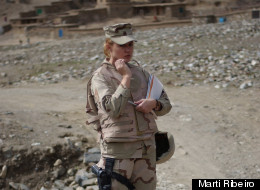
Given the military's official policy, Ribeiro says, women veterans face dismissive treatment from the VA's staff, too. "They're getting denied filing for PTSD because they're not allowed in combat," she says. "The VA's looking at them going, 'You're not allowed in combat.'"
In their February report, Defense Department officials say they have learned much over the last decade "regarding the demands of operating for extended periods at the limits of human capability." But until they're satisfied that women won't hamper units operating at those limits, they say, broader changes to the 1994 rule remain off the table.
FORCE-READINESS AND THE FAST TRACK
Pentagon officials say they plan to develop gender-neutral physical standards and use the coming changes as a step toward more fundamental reconsideration of the 1994 rule. "As a former infantry battalion commander, I can tell you I wish I'd had the opportunity afforded by this change to policy," says Patton, the personnel policy director. "Commanders want the best talent available to maximize their unit's capabilities."
The 14,325 positions, Patton adds, mark the beginning of a process, not the end. Defense officials often hedge, however, when it comes to eliminating gender restrictions entirely, with the caveat, "where feasible while maintaining force readiness."
Translation: Barring outside pressure, enlisted infantry, special operations units and other elite, especially intense military positions are likely to remain denied to women for the foreseeable future, as is the advancement that comes with them.
That's not to say women cannot rise through the ranks, as Duckworth, Trowell-Harris, Cornum and others have demonstrated. But while women account for 14.5 percent of active-duty military personnel, they make up just over 7 percent of general officers.
The Defense Department calls these figures "strong," because far fewer women than men serve for more than 20 years, and it generally takes longer than that to reach a senior rank. (Generals, for example, typically put in 30 years.) Given that, the DOD's February report concluded, women are not disadvantaged under the current assignment policy.
Yet the Military Leadership Diversity Commission reports that while the percentages of occupations open to women "do not appear inordinately low, exclusion from these occupations has a considerable influence on advancement." In the Army, where only two-thirds of positions are currently available to women, four in five general officers came from the third of positions that are not.
"You're keeping women from rising from the ranks," Duckworth says. "You need to have some real combat under your belt. You want them to have a shot, just like you would want anyone to have a shot."

For her part, Duckworth says she stayed with the military because she "fell in love" with the physical and psychological demands. And given clear physical standards, she argues, there is no reason to keep women out of infantry or special ops. "Let's not bar a few women who might be capable of doing it," she says, "same way we wouldn't bar a man from a desk job."
"Any general who doesn't think, any politician who doesn't think women can handle it" is sorely mistaken, says Srinivasan, the platoon commander. As for space-sharing and privacy, he says, "We're all adults."
The "legacy thinking" restricting military women is a kind of "iceberg," says Cornum, alluding to her work on the "comprehensive soldier fitness" program, which treats psychological well-being like physical well-being. "That's one of the skills we teach," she says, "to recognize that you have an iceberg, a deeply held belief that may be getting in the way of you seeing what's going on around you."
In any case, she says, future servicewomen have time on their side. "Eventually," she says, "everybody who believed the world is flat died off."
'THE INVISIBLE ONES'
For veterans like Latoya Lucas or Tammy Duckworth, the costs of their service are visibly striking, undeniable. But when women's wounds are tougher to spot, since they should not officially be facing the rigors of ground combat anyway, the military bureaucracy has often left them unseen or unaddressed. This blind spot forced Ribeiro to take her story public, and it nearly cost Jennifer Crane her life.
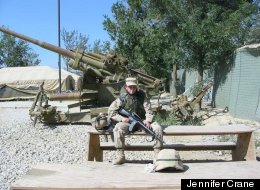
"We were in a valley," she says. "They could literally just stand on the edges of the cliffs and drop bombs on us."
Within the first two weeks, she saw her first military funeral after a friend who deployed with her dropped dead of a heart attack. By the latter half of 2003, she found it difficult to eat or drink, and became consistently, critically malnourished and dehydrated. To her superiors' credit, she says, they tried to send her home, but she managed to convince them she'd pull through -- until her heart began racing and the base medics were unable to slow it back down. At that point, she was at constant risk of a heart attack herself.
Spc. Crane was forcibly evacuated from Afghanistan. Her official discharge was administrative separation: adjustment disorder. "I couldn't 'adjust' to wartime service," she says of the Army's assessment, with a hollow laugh. "A physical condition, not a disability."
Years later, the Defense Department began recognizing such cases as post-traumatic stress. "If I would've known then what I know now," Crane says, "I might have been able to get actual retirement from the military."
She was home in time for Christmas, but it wasn't home anymore. Nightmares kept her from sleeping much, and even while she was awake, she'd have sudden flashbacks, feel like she was back in Afghanistan. Loud noises or lights, from sirens to fireworks and thunderstorms, would leave her hyperventilating or unconscious.
Yet because Crane's PTSD went undiagnosed, she says, she struggled even to seek help. "I stigmatized myself because I was a woman," she says. "Other people, they'd been through it, lost limbs, been in firefights and everything else. I really discounted my own experiences. Quite a few years self-medicating, getting rid of the nightmares, the flashbacks. Getting rid of myself."
In 2004, Crane started using cocaine, which ended her nightmares by keeping her awake -- she barely slept for a month. Her boyfriend kicked her out, and her drug use left her unwelcome at her parents' house, too. She started self-mutilating. After attempting suicide, she was admitted into a VA program, where she was diagnosed with PTSD. By that time, however, she was far gone: After the five-week VA program ended, it was "right back down the hill," to crack.
She spent two years homeless. "I had decided I was gonna let the drugs kills me," she says. During that time, she started paying her dealers in sexual favors.
In a desperate moment, she says, she prayed for help, for someone to save her. "And 12 hours later," she laughs, "I was arrested."

That friend, Jason, is now her husband. Their daughter, Hailey, turns 4 on May 17, a few months before Crane is to begin nursing school. She was recently awarded a fellowship to work at the VA.
The military and the VA have come a long way in treating veterans since 2003, Crane says. She remains concerned, however, for the latest waves of returning troops, especially the women. People still tell her she doesn't "look like a vet."
"I had high commanding officers question me once, about how I had PTSD if I was JAG Corps," she says. "I think them allowing women to be in more 'combat fields' could dramatically impact the respect women get in the military."
Military women who do not have combat decorations, high rank or visible war wounds often do not receive enough respect from their peers, Crane says. But the greater problem, she says, remains the skepticism that meets such women when they seek treatment or other help.
"It's the invisible ones we're struggling with," she says. "These veterans could just fall through the crack. And we may never hear from them again."
'LET'S NOT WAIT TOO LONG'
Defense Secretary Leon Panetta has directed the services to update him on military gender integration in November. His department's upcoming changes carry the caveat, however, that the Pentagon respects Congress' intent to "remain the arbiter of the ground combat exclusion policy."
Servicewomen have found some advocates in Congress. Duckworth hopes to join them. But as in the Pentagon and the court of public opinion, there are those on Capitol Hill who turn a blind eye to or even dismiss women's service.
"What else has she done? Female, wounded veteran ... ehhh. Now let's move on," Rep. Joe Walsh (R-Ill.), the freshman incumbent Duckworth is looking to unseat, said of his opponent in March. "Wearing the uniform should immediately earn everyone's respect," he said in a statement after the minor furor his earlier comments caused. "It should not, however, earn everyone's vote."
Through a spokesman, House Armed Services Chairman Buck McKeon (R-Calif.) declined to comment.
On the campaign trail, the Pentagon's February announcement of new openings for women elicited opposition from then-presidential candidate Rick Santorum, once the third-ranking Republican senator and a favorite among social conservatives. "I do have concerns about women in front-line combat," Santorum said. "I think that could be a very compromising situation."
Retiring Sen. Olympia Snowe (R-Maine) counsels patience, predicting in an email that "barriers that prevent women from serving in certain roles will continue to fall in the years ahead." But Rep. Niki Tsongas (D-Mass.), who serves on McKeon's armed services committee, says women have waited long enough. "Let's not wait too long to do more," Tsongas says.
On her first trip to Afghanistan, Tsongas recounts, she had lunch with a female first lieutenant, whose brother had worked on Tsongas' campaign. Three weeks later, the woman was killed by an improvised explosive device -- a testament, Tsongas says, to the combat risks women already face.
"I think the steps they've made also acknowledge there's an inevitability to this," she says of the Pentagon, citing estimates that women will comprise as much as 25 percent of the military by 2025.
Beyond Capitol Hill, however, Cornum says her decades in the Army taught her that any policy change will come slowly, citing "don't ask, don't tell," the longstanding, now-repealed ban on openly gay service members. Positions like hers started becoming available to women, she says, because the military found it increasingly difficult to enlist enough men.
Retention remains a problem for the armed forces, with multiple deployments sidelining ever-greater numbers of veterans. "We live in a country where the same 500,000 to a million people have been going to war over the past 10 years," says Srinivasan, the Army platoon leader. "Anyone who is willing to volunteer, more power to them. Who is our nation to judge?"
Ultimately, necessity may force the end of the 1994 rule, though the military's stated plan is to radically reduce ground combat operations in the coming years. "We cannot exclude an entire force of very capable people who can do those jobs," says Duckworth, who became a Black Hawk pilot because aviation was the closest she could get to ground combat.
After her shootdown, Duckworth refused medical retirement. Now a lieutenant colonel, she still drills with the National Guard.
"We're warriors," she says. "We're not victims."
